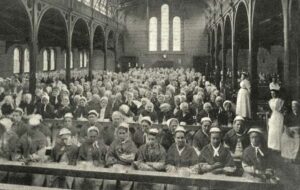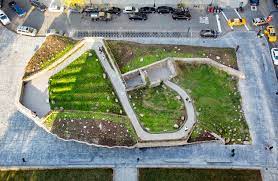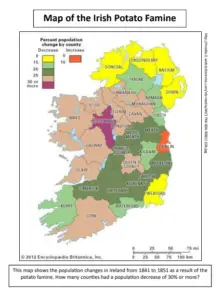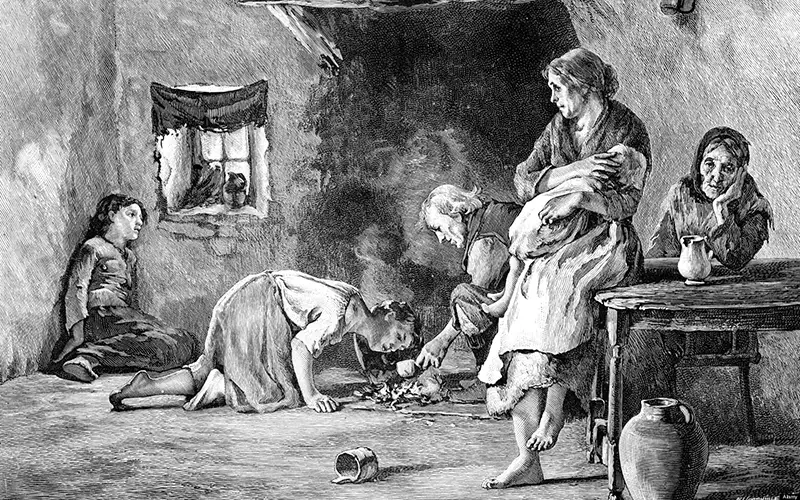IrishWishes.com has acquired the domain IrishFamineProject.com and IrishFaminePots.com as we want to continue building on the work of these sites in highlighting the Irish Potato Famine and the consequences of it.
IrishWishes.com is focused on exploring all topics related to Irish culture, Irish traditions, Irish mythology, and Celtic culture.
We have previously focused on the Irish language and Celtic-Irish boy names and Celtic-Irish girl names but we are branching out into other culturally relevant topics.
IRISH POTATO FAMINE
The Irish Potato Famine was a mass starvation event, that caused disease, emigration, and death in Ireland. It is also known as the Great Famine or an Gorta Mór in Irish.
The consequences of the Irish Potato Famine were terrible for the Irish people. One million people died and another million were forced to emigrate from the country.
Shockingly, to this day Ireland’s population has not recovered as the island of Ireland currently has 5 million inhabitants, whereas the population pre-1845 was 8 million.
The Importance Of Potatoes In Irealnd
Before the famine, the potato was a crucial staple food in Ireland especially for the poor. A single acre of potatoes could feed a family for a year, and the crop was easy to cultivate in the Irish climate.
The potato was so central to the Irish diet that many people consumed little else, making them highly dependent on this single crop.

When Was The Irish Potato Famine?
The Irish Potato Famine occurred between the years of 1845 and 1852. However, as stated earlier, the effects of the famine are felt even to this day.
For example, the genetic disorder haeomochromatosis may have developed in the Irish population after the Irish Potato Famine as a gene mutation, in order for the body to absorb extra iron.
What Caused The Irish Potato Famine?
A fungal disease called late blight arrived in Europe from the Americas and quickly spread to Ireland. The disease caused the potato plants to rot in the ground, and the resulting harvest was meager at best.
With each passing year, the blight continued to destroy potato crops across the country, leading to widespread food shortages.
British Government Response
As Ireland was owned by the British Empire at the time of the Irish Potato Famine, it did not have its own parliament and was ruled directly from Westminster in London, with Irish MP’s sitting in the UK parliament.
As a result, the British government was responsible for the solutions to the famine. Their response was slow and hugely inadequate. Initially, they implemented measures like importing corn from America, setting up public works programs for the unemployed, the creation of workhouses, and providing financial assistance to landlords.
However, these measures failed to address the scale of the disaster. The British government’s adherence to laissez-faire economics and their reluctance to interfere with market forces further worsened the situation.
Food continued to be exported from Ireland to Britain during the Irish Potato Famine (especially cattle), and many Irish people could not afford the imported grain. This lack of adequate intervention contributed significantly to the suffering of the Irish population.

Irish Potato Famine Workhouses
Workhouses as they are commonly known in Ireland, were set up to house those who could not house and feed themselves. They were segregated by gender which meant the splitting up of families.
Housed poor were forced to work for their board and keep, often performing pointless tasks like building roads and walls in the middle of nowhere. This was hard calorie intensive work which these people could ill afford and only worsened their situation.
To this day, one can still see stone walls all across Ireland’s countryside that were built by the occupants of these workhouses.

The Consequences of the Irish Potato Famine
The Irish Potato Famine had severe and far-reaching consequences for the people of Ireland. Around one million people died due to starvation and disease.
Another one million emigrated, mostly to the United States. The Irish truly were the first refugee population to arrive on American shores. The Irish population declined by approximately 25%, and the social and economic effects of this loss are still felt today.
The famine also caused political unrest, as the British government’s failure to adequately address the crisis fueled Irish nationalism. This eventually led to the formation of anti-British and pro-independence groups such as the Irish Republican.
Impact On Irish Society
The Irish Potato Famine has had a lasting impact on Ireland and its citizens. Besides the dramatic drop in population, it caused the destruction of the rural population and rural life.
The rural population far exceeded the urban population at the time of the famine, but this was heavily reversed in the following years. Ireland’s countryside to this day is dotted with abandoned homes and farms where once there was thriving communities.
The economic hardship of the famine caused a consolidation of land ownership in Ireland as many small farmers were forced to sell their land to larger landowners to survive.
The loss of life and the mass emigration of the Irish population also led to a decline in the Irish language and traditional Irish culture as those most affected were the poorest, who tended to be the least integrated into the more culturally British civil society that existed in the larger urban areas.
Irish Famine Memorial NYC
The Irish Potato Famine is commemorated in Ireland and around the world through monuments, museums, and educational programs. These efforts aim to ensure that the suffering and loss experienced by the Irish people during this dark period in history are not forgotten.
A great example of a memorial is the Irish Famine Memorial NYC. The memorial is a rebuilt 19th Century cottage from County Mayo and is a real-life example of the housing that the rural Irish poor had at the time of the famine.

Irish Famine Memorial Boston
The Irish Famine Memorial, located in downtown Boston, Massachusetts, is a poignant and striking tribute to the victims and survivors of the Irish Potato Famine Boston, being one of the main destinations for Irish immigrants during this period, is an apt location for the memorial.
Designed by sculptor Robert Shure, the memorial consists of two bronze sculptures depicting contrasting scenes: one portrays a starving Irish family, huddled together in despair, while the other shows an immigrant family arriving in America, full of hope and determination.
The sculptures are placed on a granite plaza adorned with eight narrative plaques that provide historical context and tell the story of the famine, its causes, and its impact on Ireland and the United States.
In Boston, the Irish immigrants became an integral part of the city’s fabric, contributing to its growth and development. Today, the city boasts a thriving Irish-American community, which takes great pride in its heritage and continues to celebrate its Irish cultural traditions.

Was The Irish Famine Genocide
It is not fair to say that the Irish famine was genocide based upon the definition of the word genocide but that is the most charitable one can be to the British government of the time.
They displayed willful ignorance and sometimes downright cruelty to an extraordinary degree. The free-market above all mentality that dominated British politics at the time led to a late and inadequate intervention. Additionally, the attempt to save face caused untold suffering amongst the Irish population.
The British Government refused a large donation by the Sultan of the Ottoman empire, as his donation was larger than the Queen of England’s. The reality is that they simply did not care about the Irish population one way or another.
It is a reasonable argument that the British government has attempted to genocide the Irish population on multiple occasions before this with the introduction of penal laws, the outlawing of Irish and Irish customs, the harsh rules on Catholics in public office and as landowners.
Irish Famine Map
As can be seen in the image below, some areas where completely devastated by the famine and large percentages of the local population either died or emigrated.

Irish Famine Pots
During the Great Famine of 1847 in Ireland, a famine pot was stationed on the roadside in the Townland of Cullionboy, in the Parish of Townawilly in County Donegal.
This pot eventually became the property of a local farmer named Patrick Colhoun. In the years following, this pot was utilised by local farmers to heat water when they dipped sheep.
In July 2011, an individual embarked on a quest to find the famine pot. It was discovered in a damaged state, broken into several pieces. A close inspection determined that only two small pieces of the pot were absent.
One of these fragments was recovered a few days later in a nearby stream. The restoration of the famine pot to its original state was made possible through the expertise of Stephen Jarvis, who was tasked with the challenging duty of welding the pieces back together.
A particular appreciation was expressed to the Colhoun Family who granted permission for the restoration of the pot.
Their only request was for the pot to be respected in light of its historical significance and placed in a permanent location within the Parish as a memorial to the famine victims, emigrants, and survivors.

A site at Leghowney Community Hall, a building central to the community since its establishment in 1937, was agreed upon as the most appropriate location.
In 2012, Mattie Lennon and this individual initiated research into the history of the famine pots and their critical role during the famine years.
Despite the existence of numerous publications discussing the famine, they noticed that the role of the famine pots had been largely overlooked due to bigotry, pride, misguided patriotism, and inherited misinformation.
The famine pots stand as a poignant reminder of a bleak era in history when over a million Irish people succumbed to starvation and famine-related diseases and a million more were forced to emigrate, many of whom perished aboard the infamous ‘coffin ships’ bound for the so-called ‘land of promise’.
There’s an expression which says that if slabs were laid to commemorate every Irish person who died at sea during the famine, one could walk dry-shod to America.
The restoration of this invaluable artifact wouldn’t have been feasible without the help and support of numerous individuals, namely; The Officers/Committee Leghowney Hall, who provided the site and the financial resources for the pot’s restoration, the Sweeney family, Aodh O Donnell, James Cassidy, John Cassidy Stephen Jarvis, Athy Co-cooperative foundry County Kildare, and the C. I. E. writers group.
Earlier that year, they decided, along with An Lar and Donegal TV, to create a 30-minute documentary about the famine pots.
The documentary was set to be screened in early 2014. In an attempt to determine how many famine pots were still in existence, Mattie Lennon issued an appeal for information from the public through a letter to the Irish Times and other media outlets.
The response was overwhelmingly positive, with many people sending emails, photographs, and stories of famine pots in their areas.
Over the preceding twelve months, they were able to locate several of these priceless artifacts. They continue to welcome any information or photos of famine pots from different regions.
Famine Times In Donegal
The Great Famine, known as An Gorta Mor in Irish, spanned from 1845 to 1850 and was the result of a catastrophic failure of the potato crop.
This event marks the most devastating occurrence in modern Irish history, leading to the death of a million people from starvation and disease linked to the famine.
Over a million were also forced to emigrate, with a significant number of them perishing aboard the so-called ‘Coffin Ships’ bound for what they hoped would be a better life.
Between 1852 and 1854, an additional 522,000 individuals, including a family by the name of Kennedy from Wexford, left Ireland. Throughout the famine years, Ulster saw a death toll of 111,400, a number that was mirrored in many other counties, including County Donegal.
The yearly breakdown of fatalities in County Donegal during the famine was as follows:
- In 1845, 400 individuals died.
- In 1846, the death toll rose to 1,700.
- In 1847, the number of deaths spiked to 5,000.
- In 1848, 3,500 lives were lost.
- In 1849, the death count was 2,500.
- In 1850, the deaths decreased to 130.
The overall loss of life in these years surpassed 13,000 people.
During the harsh winter of 1847, the inhabitants of Donegal Town demonstrated immense compassion and altruism towards a group of impoverished islanders who arrived at their harbor.
This unfortunate event was the fallout of a merciless plan devised by Walter Chorley, who had bought Arranmore Island for £200. His intent was to evict all sub-tenants, consolidate larger holdings, increase the rent, and subsequently profit from the venture.
When his proposal to declare Arranmore as a separate electoral district from north or south Templecrone was dismissed by the Poor Law Guardians, Chorley pivoted to another strategy.
He aimed to absolve himself of any responsibility towards the evicted tenants, planning to discard them on the mainland. As a contingency, Chorley chartered a ship, anchored it at Donegal town (35 miles from Arranmore), and told the evicted tenants that the ship would transport them to Canada without any charge.
With the expectation that hundreds of evicted tenants would navigate the challenging mountainous terrain to reach Donegal town, Chorley executed his plan. Many families sought refuge and assistance from relatives in Templecrone, unable to confront the daunting journey.

In harsh, cold conditions, the evicted group commenced their treacherous trek towards the Gwebarra River crossing. After successfully crossing the river, they continued on to Glenties. As nightfall encroached, some, weakened by cold and fatigue, failed to reach Glenties.
Those who managed to reach Glenties sought shelter in the Workhouse. However, the Workhouse couldn’t accommodate the large influx of people, leaving many exposed to the harsh weather conditions. Particularly susceptible were the sick and elderly, and for some, their journey ended there in the cold.
The next morning, some chose the humiliation of the poorhouse over facing an uncertain voyage. The rest of the group persevered, continuing their journey to Donegal Town, only to find out that Chorley’s chartered ship had not yet arrived.
The destitute islanders’ arrival in Donegal town is described as “indescribably miserable.” Reportedly, they lay on the pier for days, waiting for their ship to Canada. Had it not been for the food and clothing provided by local residents, they likely would have succumbed to hunger and exposure.
Their journey continued as they finally boarded the ‘Chorley ship’ and sailed through the Hassan’s on March 6th, 1848.
Despite the harrowing stories they had heard about the miserable conditions aboard these ships, they saw this voyage as the promise of a better life after all the horrors they had endured.
Many of the islanders who made it to Canada settled along the shores of the Great Lakes. There, they built a new life, leveraging their island skills to their benefit.
The Truth Behind The Irish Famine
Whether the British government purposefully caused the deaths of the Irish population can not be proved based on official documents which is why it cannot be claimed irrefutably as genocide, but it was a horrific event that was allowed to occur and exacerbated by an uncaring British government.


